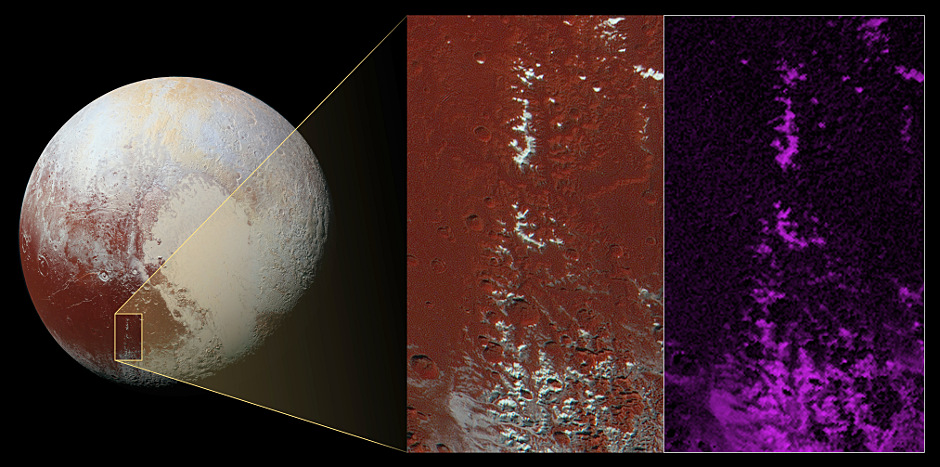
One of Pluto’s most identifiable features, Cthulhu (pronounced kuh-THU-lu) stretches nearly halfway around Pluto’s equator, starting from the west of the great nitrogen ice plains known as Sputnik Planum. Measuring approximately 1,850 miles (3,000 kilometres) long and 450 miles (750 kilometres) wide, Cthulhu is a bit larger than the state of Alaska.
Cthulhu’s appearance is characterised by a dark surface, which scientists think is due to being covered by a layer of dark tholins — complex molecules that form when methane is exposed to sunlight. Cthulhu’s geology exhibits a wide variety of landscapes — from mountainous to smooth, and to heavily cratered and fractured.
The reddish enhanced colour image shown as the left inset reveals a mountain range located in southeast Cthulhu that’s 260 miles (420 kilometres) long. The range is situated among craters, with narrow valleys separating its peaks. The upper slopes of the highest peaks are coated with a bright material that contrasts sharply with the dark red colour of the surrounding plains.
Scientists think this bright material could be predominantly methane that has condensed as ice onto the peaks from Pluto’s atmosphere. “That this material coats only the upper slopes of the peaks suggests methane ice may act like water in Earth’s atmosphere, condensing as frost at high altitude,” said John Stansberry, a New Horizons science team member from Space Telescope Science Institute, Baltimore, Maryland. Compositional data from the Ralph/Multispectral Visible Imaging Camera (MVIC) on NASA’s New Horizons spacecraft, shown in the right inset, indicates that the location of the bright ice on the mountain peaks correlates almost exactly with the distribution of methane ice, shown in false colour as purple.
The resolution of the enhanced colour image is about 2,230 feet (680 metres) per pixel. The image measures approximately 280 miles (450 kilometres) long by 140 miles (225 kilometres) wide. It was obtained by New Horizons at a range of approximately 21,100 miles (33,900 kilometres) from Pluto, about 45 minutes before the spacecraft’s closest approach to Pluto on 14 July 2015.



